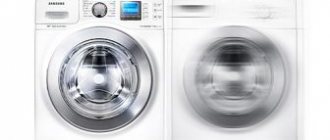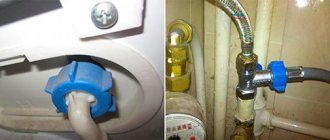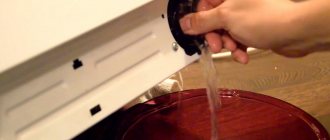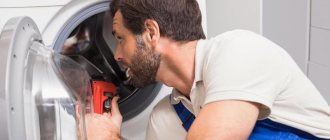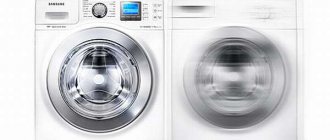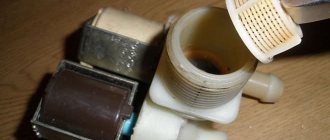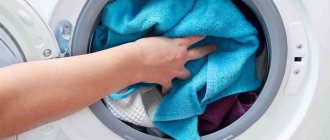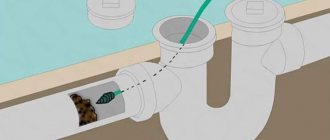Article rating
Helped me
96.4
Did not help
3.6
Question: Why does the washing machine jump during the spin cycle and constantly move? What could be the reasons?
The washing machine jumps during the spin cycle - this is due to destabilization during operation (washing clothes) or an unstable floor surface. Also, if there is vibration, you should check for defects - the drum, shock absorbers and bearings. Place on a hard, level surface.
Instructions: what to do if the washing machine jumps during the spin cycle:
- The legs may not be adjusted : The legs of the washing machine should be adjusted to the building level.
- Transport bolts not removed : Make sure there are no transport bolts.
- Shock absorbers are faulty : Check the condition of the shock absorbers.
- A slippery floor surface causes displacement.
- The drum bearing is crumbling : Check the drum bearing.
Simple faults
During the washing process, the washing machine may freeze and stop. There are various reasons for equipment failures. Next, we will consider the most common causes of simple machine failures.
The weight of the laundry exceeds the norm
Some modern washing machine models are equipped with an intelligent sensor that monitors the weight of the laundry in the drum. If the machine stops, you need to remove some of the laundry from the washing machine drum and start the wash again.
What if there was an error in choosing the washing mode?
This may cause problems with the washing machine's electronics. Quite a simple mistake, but can cause serious problems.
Don’t forget that before you start using the washing machine, you need to carefully read the instructions and only then start using it.
The instructions describe in detail all washing modes and programs, why each is needed and how to use it. And if the washing process suddenly stops, it is better to read the instructions again.
For example, if you select the “soaking” mode and then “bleaching”, the machine will not complete all washing modes, but will stop in the middle. Under no circumstances should you run two such modes: “soaking” and “whitening”. It is forbidden.
But if the modes were started and the machine left the washing process, then you should immediately seek help from a qualified technician. You should not look for a solution to the problem on your own. This may take a lot of time, but it is not a fact that all this will be crowned with success. The specialist knows exactly what needs to be done in this situation.
First of all, he removes the control unit of the washing machine, using a special device called a “multimeter”, the master will begin to look for the error due to which the malfunction occurred.
Imbalance in the drum
Sometimes a situation arises when the laundry being washed collects in a lump in the drum. As a result, the imbalance sensor turns on and the washing stops.
If such a situation arises, it is necessary to open the loading hatch of the washing machine and distribute the laundry inside the drum. Then restart the spin function.
Sensors prevent emergency situations from occurring. Such situations include excessive load on the motor due to excessive weight of the laundry, as well as vibrations due to imbalance. These measures prevent and stop household appliances from overloading.
Wrong program selected
Sometimes users select several washing modes at the same time. As a result of such an error, the washing machine stops without finishing the wash. For example, the Soak and Whitening modes should be run separately.
Manufacturers of washing machines describe all modes and programs in great detail in the attached instructions. Read the instructions for your washing machine carefully to avoid simple mistakes. The washing machine operates strictly according to the selected program, so you should be careful when choosing a mode.
Leakage protection system activated
Occurs when the rubber seal of the hatch or the pipes inside the car (most often the “drain”) are damaged.
It is necessary to turn off the water supply tap, disconnect the machine from the electricity, take out the laundry, and drain the water. It is imperative to find the leak. You can do this yourself or call a specialist. By the way, after turning on the machine again after 10-15 minutes, the error may disappear. This means that these are sensor errors.
Blockage
Sometimes the washing machine stops working because the water does not flow well into the drum. This is caused by the formation of blockages in sewers or equipment hoses. As a rule, this becomes noticeable during spinning or rinsing.
Blockages can occur in the hose itself through which water flows, in the pump or filter. It is difficult to determine the exact location of the blockage on your own. However, you can try to solve the problem yourself.
First of all, you need to clean the drain filter: this is where blockages most often form. The filter is located in the lower left part of the machine on the front side.
- Remove the protective panel
- Find the filter and start turning it counterclockwise.
- Before doing this, it is better to tilt the device back a little and place a basin under the filter. Excess water will drain and the hole with the filter can be cleaned.
- Next, return the part to its place and try to start the wash.
You can also clean the drain hose yourself. Using a screwdriver, unscrew it from the washing machine and sewer pipe, clean it with boiling water. For mechanical cleaning, you can use a long pin or strong wire. After the dirt has been removed, return the hose to its place.
Sometimes blockages occur in sewer pipes. Before calling a plumber, try to get rid of the problem yourself. Fill the pipe with boiling water, and if this does not help, use special chemicals for cleaning pipes.
The worst thing is when the pump becomes clogged. Theoretically, you can clean the pump yourself. However, the risk that you dismantle it incorrectly or damage it during installation is too great. Therefore, if regular cleaning of pipes and filters does not help, it is better to call a specialist.
Extraneous knocking noises are heard during operation
As a rule, extraneous noise appears during spinning, when the engine is running at maximum speed. There are two main reasons for the appearance of strong vibration and extraneous noise:
- Bearing wear;
- Wear of shock absorbers.
On average, bearing operation is designed for 7-10 years. In order to determine problems in the bearings, you need to take the drum with your hand and slightly rotate it back and forth and from side to side. In this case, no extraneous sounds should be heard, and the play between the edge of the drum and the cuff should be minimal. If at least one of the signs is present, the bearings must be replaced. This is a rather labor-intensive and complex repair of a washing machine malfunction, and not everyone is able to do it with their own hands.
The process includes complete disassembly and removal of the tank and drum, pressing out the bearings and seal, installing new bearings, and then reassembling them.
Spinning up the tank
We remove the drum enclosed in a sealed tank from the machine. Unscrew the tank, then remove the drum
We take out the drum
As a rule, there is a significant limescale deposit on the drum. Clean it with WD-40 rust remover.
Pressing out the bearings
Carefully remove the old bearings. This process is called pressing out. This must be done extremely carefully so as not to damage the shaft tip. It is better to use a rubber hammer.
Installing new bearings
We install new bearings on the seat, having previously lubricated the niche with lithol. Be sure to install a retaining ring on top. When reassembling the tank, be sure to use silicone sealant.
The second common cause of knocking and severe vibration is wear of the shock absorbers. Shock absorbers cannot be restored or repaired, and if they break, only replacement will be required.
Replacing shock absorbers
Serious faults
If the washing machine freezes and stops during the washing process and all the steps described above did not help, then most likely a more serious breakdown has occurred. In this case, it would be wise to contact a service center for help. The washing machine may not perform the functions you have specified and may stop completely for the following reasons:
- the washing machine motor has closed;
- the heating element or contacts of the supply wires have burned out;
- the drain pump pipe or filter is clogged;
- The drain pump is faulty;
- The programmer or electronic equipment has failed;
- The washer door lock is broken.
If a malfunction occurs, first find out what happened and also determine which element of the washing machine has failed and is causing the machine to stop. Then find out how to fix the problem in your particular case. You shouldn't act at random. After all, then the situation could get even worse.
Sensor malfunctions
If the device starts a normal cycle, but suddenly freezes or turns off, then the cause may be faulty sensors.
- laundry balance sensor;
- speed control sensor;
- pressure switch (water level sensor);
- temperature sensor.
They are used to control all major processes at each stage of the cycle. If one of the sensors is faulty, it begins to transmit incorrect information. As a result, the washing machine may freeze, since the control unit cannot understand the current temperature, water level, and so on. The device may stop during rinsing, washing or spinning.
To troubleshoot problems, contact a service center. Here, specialists will conduct tests and identify the damaged element. After this, the sensor will simply be replaced.
Heating element malfunction
Freezing and stopping of the washing machine can occur at the very beginning of the wash cycle. This may occur due to a failure of the heating element (heating element) or burning of the wiring supplying power to it.
With such a malfunction, difficulties arise with heating the water in the washing machine, and the entire sequence of specified actions is disrupted. If the timer freezes, it is necessary to check the entire electrical circuit.
Pump fault
If the machine cannot pump water out of the drum within the allotted time, it will stop working. The device should be de-energized and use an emergency drain hose. On Samsung models it is located at the bottom of the filter.
In order to inspect the part, you will need to turn the washer on its side and unscrew the bottom. If the pump malfunction is caused by mechanical blockage, for example, hair and threads wrapped around the impeller, cleaning will be sufficient. If the motor is burnt out, a complete replacement will be required.
The drain system is clogged
The washing machine may stop working during the spin cycle if the filter or the pipe that goes to the drain pump is clogged. In this case, you need to check:
- Drain hose;
- Filter;
- Drain pump;
- Sewage system;
- Tank drain hole;
- Sewer system.
The first thing you should check is the drain filter. If the filter is clogged, it is advisable to clean it or replace it. This whole operation is completed quite quickly.
The situation is much worse if the sewer outlet or the entire system is clogged. In this case, you will need the help of a plumber. You can clean the outlet yourself by using various chemicals. But dealing with the entire sewer system will be quite difficult.
You can clean the drain hose yourself. To disconnect the hose from the washing machine and the sink siphon, unscrew the clamps. Next, run hot water into the hose under pressure. If this does not help, take a wire with a bent end and carefully remove the clog in the drain hose.
If the washing machine stops during washing and the blockage has formed in some other place, then it is best to seek help from a specialist.
Broken hatch door
The result of mechanical damage (for example, a stuck latch or a broken hinge) or an electronic failure.
Determining the nature of the damage is quite simple. If there is no characteristic click when closing the hatch, then the problem is with physical wear of the parts, misalignment of the door or the “tongue” in the lock. To fix this problem, you can start by checking the level of the door and, if it is misaligned, adjust the fasteners using a screwdriver. If this does not help, the door will have to be disassembled, the hinges and the hatch handle can be changed.
If the sunroof does not lock when there is a click, it indicates either a malfunction of the sunroof lock sensor or problems in the control unit. Only a specialist can fix this problem.
Water entering the pan
The problem is associated either with a leaky hose or with a malfunction of the leakage sensor (AquoStop system). You need to drain the water, take out the laundry, disconnect the machine from the power supply and visually look for the problem. If it is visible, try restarting the wash. If the error does not disappear, call a technician immediately.
If the engine breaks down
The engine is the heart of the washing machine. It is thanks to the engine that the drum of the unit moves. If this part becomes unusable, the washing machine can stop at any time. This can be not only the washing process, but also rinsing or spinning. The washing machine may fill with water and stop.
In addition, a breakdown of the motor is also indicated by the fact that the drum of the device does not rotate, although the washing machine is functioning normally. It is impossible to fix such a malfunction on your own. To do this, you need to seek help from a specialist. The service will conduct a full test of the systems and then repair all faults. As a rule, the washing machine motor is simply replaced with a new one.
Causes of problems affecting water heating
There are a number of problems that can cause the water in the machine to not heat up:
- Incorrect selection of the specified program.
- Incorrect connection of the unit.
- Broken heating element circuit.
- Failure of the heating element.
- Programmer malfunction.
- Thermostat failure.
Incorrect selection of the specified program
Before you understand why the washing machine does not heat the water, you need to make sure that the washing mode, which is set manually, is selected correctly. This is especially true for those models in which the cycle program and temperature mode are switched on separately. If there is a discrepancy between the program mode and temperature selection, the machine will default to the set program, and there the temperature may be lower than expected.
To resolve this problem, you need to read the instructions in detail and make sure that you have chosen the appropriate mode.
Incorrect machine connection
If the unit is connected incorrectly, some of the already heated hot water may be drained into the sewer. With such a malfunction, new cold water constantly enters the tank, which does not have time to heat up to the required temperature. In this case, the washing machine washes with insufficiently warm or hot water, which negatively affects the quality of the wash.
The problem can be solved by connecting the equipment correctly.
Broken heating element circuit
A heating element is a tubular electric heater, the operation of which determines the correct heating of water during washing.
If the heating element or the wires going to it fail, the washing machine will not be able to heat the water. Before inspecting the heating element itself, you need to make sure the integrity of the wires that go to it. Since the wiring is located in close proximity to the body of the machine, it is often subject to mechanical stress and can therefore become chafed or damaged.
If upon inspection it is discovered that the wires are faulty, they must be soldered and insulated or replaced with new ones.
Failure of the heating element
A broken heating element is the most common reason why a washing machine does not heat the water. The device constantly heats up and then cools down, which often leads to wear and tear. In addition, the element is located in water, which contributes to the formation of scale.
A faulty heating element requires replacement, but before installing a new element, you need to make sure that the old one is out of order. How to check the condition of the heating element? To do this, you will need a multimeter that will help determine the resistance of the working device. After watching the video, you can see how the performance of the heating element is checked using a multimeter:
The test consists of connecting the heating element terminals to the measuring apparatus in order to determine the resistance value of the device. If the resulting figure is equal to the previously calculated resistance value, the heating element is serviceable; if the indicators are lower, the device requires replacement.
After this, it is necessary to check the breakdown on the heating element body. To do this, turn on the “buzzer” function in the multimeter and connect it to the output of the heating device and its body. If the device gives a signal, there is a breakdown of the heating element on the housing, and it needs to be changed, if not, everything is fine with the device.
If it turns out that the machine does not heat water due to a malfunction of the heating element, it must be removed and a new device installed. To do this you need:
- Remove the rear panel of the unit housing;
- Disconnect all wiring from the heating element;
- Remove fasteners;
- Remove the heating device;
- Place the new element in the seat, secure it and connect the wires.
During the process of replacing the heating element, it is important to remember, sketch or photograph the correct position of all wires and fasteners, in order to avoid incorrect connection of the new device
Programmer malfunction
The programmer or control module (MU) is responsible for the correct operation of all equipment elements.
If there is a malfunction in its operation, this may be the main reason why the washing machine does not heat the water. In some cases, the board can be repaired. In most cases, the module needs to be replaced. But you should not do this yourself, without certain knowledge and skills, since incorrect installation can affect the entire further operation of the washing machine.
Here are some of the most common problems
If the machine cancels the program within the first 10 minutes of washing. It is possible that the heating element has failed or the program has detected that the won is not heating for a certain limited period of time.
If the machine cancels the program after about 20-30 minutes of washing and the water is definitely getting hot, the water may be overheating. It may be caused by a faulty thermistor (a modern thermostat). It is usually located just behind or attached inside the heating element and is a type of resistor that changes its electrical resistance depending on its temperature. Overheating of water is a very insidious problem to fix yourself.
Sometimes washing machines interrupt the washing process if they detect that at least one of the parts is leaking onto the floor. To check this, you will need a meggometer, which usually only has. The insulation test will involve running 500 watts of current through the machine.
The life of a modern person is made easier by a variety of household appliances. Automatic washing machines occupy a special niche of such products. Such a device is available in almost every home. Using the washing machine is very simple. The main thing is to follow all the manufacturer’s recommendations. However, in some situations the technique stops working. Why is this happening?
Common error codes when stopping the washing machine
- E11 – There is not enough water in the machine’s tank to start washing. The problem can be caused by weak water pressure or a faulty triac.
- E13 – A leak has appeared in the unit.
- E21 – Water does not drain. The drain system is clogged, the pump is broken, or the electronics module is stuck.
- E31 – The level relay is broken. The part needs to be replaced.
- E42 – UBL breakdown. You should immediately check the operation of the device to make sure there is a problem. If necessary, replace the UBL.
- E74 – The location of the temperature sensor is incorrect. It needs to be returned to its normal position.
- E85 – Recirculation pump failure. You will need to replace the pump along with the electronics unit.
- EB2 – High voltage in the network. The appropriate check must be carried out.
- ENE - The protection circuit relay has failed. The electronic unit needs to be replaced.
What could cause the malfunction?
Usually, if the washing machine suddenly stops during washing, then after some time an error code is displayed on the display, by which we can determine what kind of malfunction we are dealing with. This happens in 90% of cases, but even if we find out what malfunction caused the stop, we will still have to think about how to solve the problem, because the washing machine itself will not fix itself.
First, you need to understand the typical causes of malfunctions that cause the machine to suddenly stop during washing. Then you will need to move on to studying the nuances of these faults and methods for eliminating them. Let's start with typical breakdowns.
- You put too much laundry in the drum or put it in the wrong way.
- The user has selected the wrong washing mode.
- There were problems with the washing machine's electrical system (sensors, wires, terminals).
- There are problems with the electronic control unit of the washing machine.
- The leakage protection system has been activated.
- The hatch door does not lock properly or suddenly unlocks.
- There is a serious breakdown of the most important components of the machine: the engine, heating element or drain pump.
Note! In addition to the above breakdowns, problems sometimes arise with filler and drain valves. If the machine cannot fill or drain water normally, this in some cases can also cause the washing to stop.
Causes
The flow of water into the tank is difficult. Water may flow into the washing machine slowly or intermittently for a variety of reasons. This can be due to both the condition of the water pipes (for example, sometimes low water pressure or a blockage in the pipes is to blame) and to the device itself. Thus, blockages in the inlet hose or in the filter may interfere with the normal supply of water to the tank.
It is difficult to drain water from the tank. This problem is the exact opposite of the first, but the effect is the same. If there is always water left in the tank, the machine cannot switch to spin mode, causing the wash to take longer. Normal drainage of water is most often prevented by blockages in the drain system. They usually occur due to foreign objects getting into the drain hose or filter, accumulation of washing powder residues and dirt deposits.
There is a constant intake and drainage of water. In this case, washing can continue indefinitely, since the washing machine cannot fix the water level in the tank required to start washing. This problem can occur for two reasons. The first is errors made when installing the device to the sewer pipe. The second is a breakdown or incorrect operation of the water level sensor.
The water in the tank does not heat up. To start a given washing program, it is necessary that the water in the tank warms up to the desired temperature. If heating does not occur, or it proceeds very slowly, the wash is delayed. Two devices are responsible for heating and controlling the temperature of the water in the tank - a heating element and a thermostat (temperature sensor). The failure of one of them leads to the fact that the temperature regime of the wash is disrupted and the washing machine malfunctions.
The drum rotates without stopping or, conversely, freezes. Such a malfunction can also lead to washing taking a very long time. The most serious reason that causes such a problem is a breakdown of the electronic control unit. A less serious reason, which is much easier to eliminate, is an overloaded drum.
DIY repair
You can restore the functionality of your washing machine yourself. At least fix minor damage - change the heating element or motor brushes. However, for this you need to have basic knowledge and also have the appropriate tools.
Let's look at repairing a washing machine using the Indesit model as an example. To replace a burnt heating element, you need:
- Remove the back cover of the washing machine.
- Pull out the heating element.
- Unscrew the temperature sensor from the heating element.
- Insert the temperature sensor into the new heating element.
- Insert the new heating element back into the washing machine. When tightening the heating element, be sure to press the temperature sensor with your fingers so that it does not jump out.
If replacing a burnt heating element does not correct the problem, there may be problems with wear on the motor brushes. They are also easy to replace by removing the motor from the washing machine.
It is very important to correctly diagnose the reasons for the washing machine stopping during washing and adequately assess their danger.
Do not leave the machine unattended, sort your laundry before washing, practice turning off the water in advance, have a basin to drain the water (just in case), carefully read the “Operating Instructions.” This will save your nerves, time, money and extend the life of the machine.
Problems with the electronic control unit of the washing machine
The control unit is an important component of the device. However, it can also fail. Breakdown can be caused by strong vibration, high humidity or power surges. The control unit is the brain of the washing machine. It is he who collects all the information from the sensors and also controls the components of the washing machine. If the equipment does not function correctly, the equipment begins to freeze or stop at rinsing or spinning.
If the control unit is malfunctioning, then it is impossible to repair the washing machine at home. In case of such a breakdown, the washing machine should be taken to a service center, since there is special equipment that allows you to determine the malfunction. If it is impossible to eliminate the breakdown, then the control unit is replaced.
How to troubleshoot
When identifying the reasons for the washing machine freezing, possible malfunctions must be approached comprehensively. All elements of the washing machine form a single system in which each element or part is connected and mutually influence each other.
If the cause of the malfunction is determined correctly, then you must:
A heating element that has failed should be replaced with a new one with similar technical characteristics;
The hatch lock (UBL) has mechanical damage and needs to be replaced. If the inspection reveals irregularities in the operation of the electrical part, for example contacts, then minor repairs can be made, but if the winding is short-circuited, replacement is necessary. Checking the winding for a short circuit or open circuit is done using a measuring device;
The electric motor is inspected for damage and checked with a multimeter. To check it, it is necessary to remove it from the washing unit and visually assess the condition of the stator, rotor, and carbon brushes. If the brushes are worn out, they are not difficult to replace, given their low cost. If there are obvious signs of winding melting, the entire engine is changed;
The drain pump is first checked for the presence of objects in it that would prevent the impeller from rotating through the drain filter. By cleaning this unit, in most cases it is possible to eliminate the blockage in the drain system. If the drain pipe or drain hose is clogged, they must be removed, cleaned and replaced.
If the cause of the malfunction is the electric motor of the pump, then the pump is most often changed completely, since the electrical and mechanical parts are made of a monoblock;
The electronic unit that became a possible cause of freezing at home can only be checked visually (lack of contact, burning of the board) or using a multimmmeter to check whether voltage is applied to it. In all other respects, it is better to rely on specialists who can not only change the necessary electronic elements, but also install the software (firmware) of the washing machine. In the event that the washing unit is stuck with water in the tank, you must:
- turn off the power to the unit and turn off the water;
- open the hatch (for machines with vertical loading), remove the laundry and empty the water from the drum manually;
- drain the water (or its residues) through the drain filter;
- start diagnostics.
In many washing machines, you can start an automatic diagnostic mode and calculate the malfunction using the error code, which is the simplest method. If this cannot be done, then calling a service center technician will be the best solution.
Self-repair and prevention
You can cope on your own by replacing some external parts of the washing machine, the rubber seal or cleaning the drain. In addition, cleaning the drain filter should be a mandatory preventative measure. It is also necessary to periodically check the permeability of all drain hoses, especially at the junction with the sewer.
The machine must be unplugged after each wash. It is recommended to leave the drum and detergent compartment open after finishing the wash cycle. This will protect the electronic filling of the machine from moisture and prevent the board contacts from oxidizing.
Call a specialist
The newer the washing machine, the more complex its design. In case of complex breakdowns, for example, electronic failures, you should seek the help of specialists. You should not trust private technicians. It is better to resort to the services of large service centers, where a guarantee of work is given. In such companies, special attention is paid to thorough diagnostics, and only then repair tactics are chosen.
Professional repair of a frozen washing machine
Breakdown of any unit, part of the washing machine, blockages, or water leakage can lead to a stop during washing.
To find out what exactly went wrong, you will need to diagnose the equipment. This is a mandatory procedure. Even if the machine reported an error code and it was possible to decipher it, you need to check the entire unit. There are several reasons for the breakdown.
Depending on the reasons, you will need:
- Clear blockages in inlet or drain hoses, filters, and sewers.
- Replace with a new water level sensor (pressostat).
- Descale or replace with a new electric heater.
- Replace the thermostat (water heating temperature sensor).
- Remove the foreign object from the space between the tank and the drum.
- Adjust the drum or replace it.
- Repair the contacts of the heating element wires.
- Replace the burnt out motor with a new one.
- Replace the pump (drain pump).
- Reflash the old one or install a new control board.
- Replace the hatch locking device.
- Replace the rubber sealing collar.
- Replace the AquaStop sensor.
The washing machine does not turn off at the end of the wash cycle
If the washing machine stops at any stage of the wash cycle, the following situations are possible:
- There are models of washing machines from different manufacturers, such as Ariston, Indesit, LG and others, which are equipped with a laundry weight sensor. Such washing machines stop the wash cycle at the very beginning if the permissible weight of the loaded laundry is exceeded.
- You need to check the selected washing mode. You may have selected a delicates cycle that stops the wash without draining the water. In this case, you need to turn on the water drain yourself.
- The washing machine may stop the wash cycle during the spin phase if the laundry in the drum forms a clump in one area. This occurs to avoid strong vibration during spinning. In this case, you just need to lay out the laundry evenly and turn on the spin mode again.
If all the cases described above are excluded, then there is a malfunction in the washing machine. If the machine stops during the washing phase, the following reasons are possible:
Reasons for stopping the washing machine during the rinsing or spinning phase:
- breakdown of the laundry balance sensor;
- shock absorber failure;
- malfunction of the speed control sensor;
- problems with the water level sensor in the drum;
- malfunction in the water drainage system;
- control board failure.
Each of these faults requires the intervention of specialists from a certified service center. The cost of repairing a washing machine can vary greatly depending on the cause of the problem.
Brakes on drain, continuous supply of water
Programs may also take longer to complete due to water draining too slowly from the tank. You will have to check some elements of the drain system. The following can lead to difficult fluid drainage:
- garbage filter clogged. The element is located on the front of the washer, in the lower right corner. The part needs to be cleaned;
- impeller damage. Check if its blades are spinning. This can be done through the hole formed after removing the garbage filter;
- clogged drain pump pipe. To correct the situation, you need to de-energize the SMA, turn off the water supply, lay the machine on its side, find the pump, loosen the clamp securing the hose and clean the pipe;
- accumulation of dirt in the drain hose or its kinks. If any defects are found, rinse or replace the tube.
Uncontrolled drainage of water from the tank also increases the washing time. Water can be drawn into the system and immediately discharged into the sewer. This happens due to:
incorrect connection of the SMA. Water is drawn up to a certain level and immediately drained. So, the required volume of water does not enter the tank, and the wash does not start. Check that the drain hose is installed at a height of 60 cm from the floor level
It is important to monitor the position of the sleeve relative to the automatic machine; failure of the pressure switch. The sensor, measuring the water level in the system, sends a signal to the control module about the possibility of starting washing when a sufficient amount of liquid is collected
If the pressure switch malfunctions, the level assessment occurs incorrectly, the washing machine does not understand whether the tank is empty or full. Therefore, water can constantly go down the drain and be collected again. Replacing the sensor will help fix the problem; interruption of the intake valve. In this case, the element does not work normally, and may not open completely or freeze completely. The problem can be fixed by replacing the part.
Thus, the cycle time increases when the drain system is clogged or uncontrolled discharge of water into the sewer. You can deal with the problem yourself. It is enough to inspect the described elements of the Indesit washing machine, clean them or replace them with new ones.
The washing machine stopped mid-cycle - what should I do?
What to do if your washing machine stops and won’t wash your clothes? How to behave if this happens over and over again? Diagnostics and repair professionals advise:
- turn the machine off and on again, it is possible that the failure in the control system was a one-time event;
- at the first occurrence of a malfunction, try starting a different washing program;
- make sure that there is water flowing into the machine and that there is voltage in the network;
- If it stops again, there is strong noise, vibration and an error message, turn off the machine and call a technician.
Never try to open the door by force or disconnect the hoses from the inlets and outlets of the machine. If you tried to drain the water in the reset mode and it failed, wait for the technician to arrive or use the valve at the bottom of the machine body.
Rinse and spin
Nowadays, developers of washing machines literally stuff their equipment with various sensors that control all the washing stages that occur. The control board monitors all indicators, and if something goes wrong, all processes stop. Only a specialist can accurately diagnose why a breakdown occurred and replace faulty components.
Failure of various sensors may cause the machine to shut down:
-if the laundry imbalance sensor becomes faulty, the system considers that the laundry is unevenly distributed and does not start the spin process. At the same time, you will see a small amount of clean water in the drum, since the laundry has already been rinsed.
— if the speed control sensor fails, the system cannot understand at what speed the drum is rotating and turns off all processes.
— the washing machine may freeze during the spin cycle, not understanding whether there is excess liquid left inside it if the water level sensor breaks down.
Since most modern washing units are able to assess the level of vibration, if the shock absorbers fail and there is a threat of resonance, they stop the spin process after some time.
Clogged hoses and filters cause the machine to stop during the rinsing and spinning phase. Water cannot flow into or out of the machine due to a blockage, and the washing process stops.
You can check and clear the drain filter of debris under the faucet by first turning off the power and draining the water using an emergency hose.
Next, you can check the clearance of the drain hose lowered into the bathroom by trying the quick wash mode without laundry.
During spinning, the equipment may stop due to the fact that the pump or pump becomes faulty. There is no pumping out of water and the system. Without wasting time, it stops all processes.
During the spin cycle the program freezes or the function does not work
The reasons for the lack of spin can be either mechanical or software at the level of control electronics. To exclude a breakdown at the electronics level, you need to run the spin function separately and see if fault codes appear on the control panel of the washing machine. If the machine has a touch control and a large screen, then a failure of the function will be accompanied by the symbols “ERROR”, followed by a digital error code. The analog control system is a little more complicated. It is represented by indicators that, when an error occurs, begin to glow or flicker.
One of the most common reasons for the failure of the spin function is the failure of the tachometer sensor or a break in the wires transmitting the control signal from the tachometer to the engine. In this case, DIY repairs seem to be quite problematic. Since it is necessary to have professional testing equipment.
Tachometer sensor
Mechanical causes of failure or poor performance of the spin function can be eliminated independently:
The belt transmitting torque from the motor to the drum has stretched. This problem occurs especially often in compact (narrow) washing machines.
Drive belt
Wear on engine brushes occurs during intensive use over a long period of time. At the same time, the washing machine works quite successfully at low speeds, but for spinning (maximum speed) the power is no longer enough.
Remove the electric motor
Remove the brushes
To replace the brushes, you need to remove the engine and find the brush holders on it (they may look different for different models), remove one of the brushes and purchase similar ones in the store. The need to replace brushes can be determined by the size of their protrusion from the brush holder. If at least one of them has less than 7 mm, then both cheeks need to be replaced.
If the program on the washing machine has gone wrong. What to do
If everything is in order with the communications, and there is no excess laundry loaded into the drum, you need to check whether the washing machine program has failed. To do this, just “reboot” the washing machine by following a few simple steps:
- unplug the washing machine from the socket;
- wait a few minutes;
- insert the plug back;
- restart the interrupted wash program.
If the reason for the stop was a program failure in the Indesit washing machine or a washing machine of another brand, the machine will start the selected mode and completely complete the washing cycle. In the future, the washing machine will work as before and there is no need to call a technician. Failures most often occur due to voltage changes in the electrical network or changes in pressure in the water supply. But if the machine stopped not because the program on the washing machine went wrong, we’ll look at what to do next in more detail.
The loading hatch does not open
The loading hatch is blocked for the entire washing process. The blocking process is controlled by a ceramic resistor. After the program has completed all the functions and the resistor is no longer supplied with power, it persists for 1-2 minutes and only after that the blocking plates take their original position and the hatch can be opened.
One of the possible causes of a malfunction of the washing machine locking mechanism is constant voltage drops. They can lead to wear of the bimetallic plates or simply burn the contacts.
Burnt lock contacts
In this case, the lock must be completely replaced. You can remove it as follows:
- We bend the cuff, gaining access to the lock;
- Unscrew the two screws;
- Disconnect the contacts.
The lock has been removed and can be replaced with a new one.
Replacing the lock
Minor problems
The fact that the washing machine turns off during washing may have several unimportant reasons that can be easily eliminated. However, they are often difficult to detect because their manifestations are not always obvious.
Drum overload
The most common reason that the device turns off a short time after pressing the “start” button is that the user has put too many things. Each model has a maximum weight that must not be exceeded. Please note that it is indicated for cotton clothing. If you plan to wash woolen items, you cannot add the same amount of laundry. It should be reduced, because such fabrics absorb much more water.
The washing machine may shut down due to the drum being overloaded due to imbalance, even if the weight is not exceeded. If you plan to wash 1-2 heavy items, they need to be carefully straightened. You can’t put them in a “clump”.
Problems with electricity or water supply
The fact that the machine stopped working during washing may have reasons not directly related to the device. This situation is possible if the water supply was cut off or the electricity was cut off.
In a situation where there has been no water for several minutes, the cycle will spontaneously start. If more time has passed, then after the problem is resolved, the user must press the device start button again. It will drain the water from the drum and start the cycle again.
Even if the user did not notice that the power was turned off or there were interruptions in the water supply, he should try to start the machine again. This situation may have been short-lived, but led to a work stoppage.
Wrong program selection
On models that offer a large number of programs and additional washing parameters, situations are possible when the user sets an incompatible combination of functions.
For example, some washing machines may turn off when the prewash and bleach modes are selected.
This will not happen immediately after startup, but when the first stage of the cycle is completed and the device proceeds to the next operation, which contradicts the previous one.
Error in the selected washing program
It happens that the owners of a washing machine, without any intention, turn on the delicate wash mode, expecting that the machine will rinse and spin the laundry.
But this program does not imply such a function and there is no problem as such.
If the washing machine stops rinsing, in this case you can forcefully drain the water by turning on the “drain” mode, and then use the “spin” program.
A similar story happens when the “Soaking – Washing – Bleaching” program is selected, because not a single washing machine will allow you to run soaking and bleaching at the same time.
The operating instructions contain a lot of information, including always describing the programs and their features.
This booklet should be at hand so that such misunderstandings do not arise.
Serious faults
If a problem arose and the machine stopped washing during the washing process, and you have already tried the above solutions and there is no result, the question arises: why does the washing machine stop during washing?
Most likely, there were serious reasons to stop work. It can be:
- breakdown of the hatch lock;
- malfunction in the drainage system;
- problem with the electric motor;
- the heating element does not work;
- The control module has failed.
In order to take any action, you need to understand what happened and who the culprit is.
The “poke” method is not an option. Here you will need consultation and diagnostics from a specialist, otherwise you wouldn’t have to change the unit in the process of self-repair.
If the hatch lock is broken
The problem appears when the door does not close tightly and does not adhere to the cuff. Most often this happens with budget washing machines, since manufacturers can save on the seal.
Problem with heating element
The machine can independently change the washing program or cancel it altogether if there is a problem with water heating or, conversely, overheating. In the first case, the water does not heat up due to a broken heating element, and in the second, the thermistor is to blame.
Sometimes the washing machine stops during operation, but after some time it starts working again.
It's not difficult to check. The quick wash mode takes approximately 30 minutes of washing time, other programs spend time differently, this is affected by the water heating temperature and the presence of additional functions.
If you notice that the machine is taking longer than before, there may be problems with the plumbing, water pressure, etc.
The drainage system is dirty
The drainage system includes: filter, pipe, drain hose, pump, drain hole and sewer.
The simplest thing you can do is check the filter and get rid of the blockage. If the drain hose is clogged, you can clean it yourself.
To do this, you need to unscrew the clamps and disconnect the hose from the machine and the siphon. Then it is washed with strong pressure of hot water. If the blockage prevents you from doing this, remove it with a wire from a hose.
Be sure to bend the end of the wire to avoid damaging the hose.
It is better to entrust blockages in other parts to a professional.
Preventive measures
To avoid problems with the quality of washing, it is enough to follow simple preventive measures. Our engineers have prepared several tips that will allow the unit to wash clothes well.
- Before loading, check the pockets: foreign objects may remain there and clog the drain system. As a result, the waste liquid will return to the device and ruin the clothes.
- Monitor the number of things you load: do not overload.
- Check the clothing care instructions: wash at the temperature indicated on the tag.
- Leave the door open after the cycle is complete to allow any remaining moisture to evaporate. Also wipe the rubber cuff with a dry cloth.
- Clean the filter and powder tray regularly.
If preventive measures do not help, things are difficult to wash, and you don’t know what the reason is, call the Remontano SC.
